NMRplusX

As part of the NMRplusX project, a hardware and software-based synthesis and analysis system has been developed that combines orthogonal spectroscopic analysis with chemometrics as a process analysis technology (PAT) for the calibration and self-optimisation of chemical processes.
Image: HPLC-Pumps (1), Thermostat (2), Thermo Reactor (3), Capillar Photo Reactor (4), Liquid Phase Separator (5), Pressure Sensor (6), Temperature Sensor (7), Pressure Valve (8), Benchtop-NMR-Spectrometer (9), FT-ATR-IR-Spectrometer (10), UV-Vis-Spectrometer (11), IR-Sensor (12), Electronic Control Box (13), Control-PC (14)
Nanalysis Corp and Fraunhofer IMM anchored multi-party international research project. TROUT GmbH and Dr. Jason Hein of the University of British Columbia joined the principals on an exciting new research project, NMRplusX.
Fraunhofer Institute for Microengineering and Microsystems IMM (Mainz, Germany) and Nanalysis Corp. (Calgary, Canada) are the national leads on a new research project funded in part by the German and Canadian governments.
The project, NMRplusX, combines orthogonal spectroscopic analysis and chemometrics as a process analytical tool for calibration and self-optimizing chemical processes. The project was scheduled to run for 30 months.
In a first step, the chemical reaction was summarized in a model using mathematical relationships. With the model it is possible to calculate the behavior of different substances in the equipment. However, results from experiments have been required for the exact calculation in order to adapt the parameters to the real conditions. The calculations are based on a numerical integration of the differential equations and can be carried out much faster than real reactions. This enables AI to be trained faster, which then still has to be “fine-tuned” using real experiments. The optimization maxima of the model are additionally verified by a numerical maximum determination. This model was used to carry out a first parameter optimization with algorithms (QN, DQN, DDPG) from the area of reinforcement learning (RL).
Find more on Fraunhofer and on Google Business




